Elmwood Cemetery has many old and beautiful grave markers. Many of the markers are adorned with symbolic representations of death, religious symbols, and personal reflections regarding the life of the deceased. Crosses with IHS, In His Service, are sometimes used as grave markers as well as lambs for a child’s memorial.
This historic cemetery has many notable gravesites. Those include members of the Dalton Gang, Dalton Raid Defenders, and other noteworthy Coffeyville citizens.
A | B | C | D | E | F | G | H | I | J | K | L | M | N
O | P | Q | R | S | T | U | V | W | X | Y | Z
Anderson, M.N. *
M. N. Anderson was a carpenter who fired from Isham’s Hardware in Coffeyville, Kansas during the Dalton Raid on October 5, 1892.
| top |
Ayers, Thomas G. (1842-1908) *
Thomas G. Ayers was born at Andover, Illinois, on May 7, 1842, and he resided there until he was admitted to the bar at Cambridge, Illinois, February 25, 1871.
 He moved to Coffeyville, May 25, 1880, and engaged in a banking business under the firm name of Ayres & Stule. This firm was afterwards dissolved and in its stead the First National Bank of Coffeyville was organized. Mr. Ayres continued in the business for some years with the new organization. He moved to Coffeyville, May 25, 1880, and engaged in a banking business under the firm name of Ayres & Stule. This firm was afterwards dissolved and in its stead the First National Bank of Coffeyville was organized. Mr. Ayres continued in the business for some years with the new organization.
In 1893, he retired from banking and went to Sioux City, Iowa, where he was treasurer of a wholesale grocery company. In 1894, he resigned and returned to Coffeyville where he resumed the practice of law. He served one term as mayor of Coffeyville.
At the time of the Dalton Raid, he was a cashier at the First National Bank where he was shot by Bob Dalton. He survived the shooting.
| top |
Barndollar, J.J. (1842-1904)
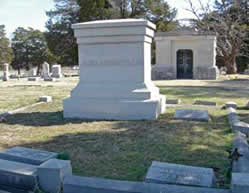 J. J. Barndollar, an early-day Coffeyville merchant, was born in Everett, Bedford County, Pennsylvania, on May 5, 1842. In 1868, he moved to Lanark, Illinois, where he resided until the spring of 1870, when he came to Humboldt, Kansas. J. J. Barndollar, an early-day Coffeyville merchant, was born in Everett, Bedford County, Pennsylvania, on May 5, 1842. In 1868, he moved to Lanark, Illinois, where he resided until the spring of 1870, when he came to Humboldt, Kansas.
In the summer of 1871, he settled at Coffeyville where he engaged in the wholesale and retail business dealing in general merchandise.
In August 1862, he enlisted in Company C., One Hundred and Thirty-third Pennsylvania Volunteer Infantry; he served nine months and was First Sergeant of his company.
| top |
Bonney, William H.
William H. Bonney is believed to be the father of Billy the Kid. The Bonney's moved to Coffeyville in 1862 when Billy was three.
William Henry McCarty (November 23, 1859 – July 14, 1881), better known as Billy the Kid, but also known by the aliases Henry Antrim and William H. Bonney, was a famous 19th century American frontier outlaw and gunman who was a participant in the Lincoln County War. According to legend he killed 21 men, one for each year of his life, but more likely he participated in the killing of less than half that number.
| top |
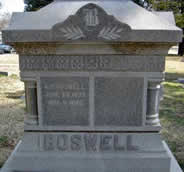 Boswell, A. P. (1837-1896) Boswell, A. P. (1837-1896)
Honorable A. P. Boswell was a capitalist and President of the Board of County commissioners. He was born near Decaturville, Tennessee, June 1837.
In July 1871, he moved to Coffeyville where he was in the business of loaning money, He was a Trustee of the Parker Township. In 1876 he was elected County Commissioner.
| top |
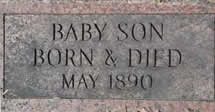 Brown, Baby Son (1890) Brown, Baby Son (1890)
This son was the second son born to W.P. and Nancy Brown. The first son is said to be buried in the Independence Cemetery, Independence, Kansas.
| top |
Brown, Charles (1832-1892) *
Charles Brown was born in Schenectady, New York, on December 26, 1832. When he was but 8 years of age, he went to Rochester, New York where he remained for seven years, during which time he completed his apprenticeship as a shoemaker. In 1847, when 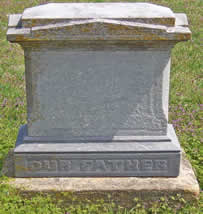 only 15 years of age, he went to California and engaged in gold mining for about 13 years. only 15 years of age, he went to California and engaged in gold mining for about 13 years.
In 1861, he returned to his native state where he remained a short time. His next move was to Wayland, Michigan, where he married Miss Emily L. Morley in the year of 1868. Two years afterwards, he moved to Grand Rapids where he worked at his trade until the fall of 1883, when he moved on a farm three miles east of Coffeyville.
He moved to Coffeyville in 1888 and opened a shoe shop, where he remained working at his trade up to the time of his sad and tragic death at the hands of the Daltons on the 5th of October, 1892.
| top |
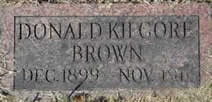 Brown, Donald Kilgore (1899-1911) Brown, Donald Kilgore (1899-1911)
Donald Kilgore Brown was born in 1899 to W.P. and Nancy Brown. He was the fourth son born to the Brown’s. He died November 11, 1911 from complications of diabetes. He died one month before his 12th birthday. He was the only Brown child to actually live in the Brown Mansion.
| top |
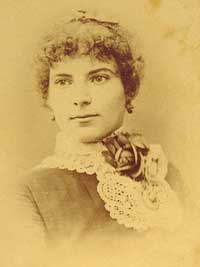 Brown, Nancy Kilgore (1863-1934) Brown, Nancy Kilgore (1863-1934)
Nancy (Nannie) Kilgore Brown was born in 1863 and was originally from Port Washington, Tuscarawas County, Ohio. She was 4’11” tall.
W.P. and Nancy were married in 1884 in Port Washington, Ohio. They met while she was visiting relatives in the Independence area. When she went home, it is said that Mr. Brown followed her and courted her in her home county of Tuscarawas. They were married there in the Moravian Church. About a year later they returned to Independence, Kansas to make their home.
They had five children: Violet who lived to adulthood; two baby sons who died at or soon after their birth; William, who died at the age of 4 from pneumonia; and Donald, who died from complications of diabetes at the age of 11.
She died August 25, 1934, at the age of 71, just over two months after W.P.’s death. Some say she died from a broken heart.
| top |
Brown, Violet Elizabeth (1885-1973) – See Kohler, Violet Elizabeth Brown
| top |
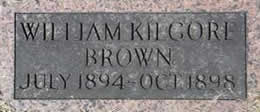 Brown, William Kilgore (1894-1898) Brown, William Kilgore (1894-1898)
William (Willie) Kilgore Brown was born in Coffeyville, Kansas in early July 1894. He was the third son born to the Brown’s. He died in October 1898 at the age of four from pneumonia. He never lived in the Brown Mansion.
| top |
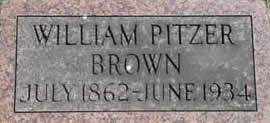 Brown, William Pitzer (1861-1934) Brown, William Pitzer (1861-1934)
W.P. Brown was one of Coffeyville’s most astute businessmen. He was born in Ohio in 1861. His father fought with the Union Army during the Civil War. After the war ended, the family moved to Independence, Kansas.
To escape a difficult relationship, Brown left home at the age of 14. His first job was collecting bad debts for a bank. He moved to Cherryvale where he started a grain dealership.
Brown met his lovely wife Nancy from Ohio, when she was visiting relatives in Independence. The Browns were married in Ohio but moved back to independence to start a lumber business. They had two sons who died in infancy then four-year-old Willie died of pneumonia in 1898 and son Donald died at age 11. Violet, their first child and only daughter, was their only child who lived to adulthood.
The Browns moved to Coffeyville in 1890, and turned an old carpentry shop into a lumber company. Several years later, Brown smelled natural gas outside his company’s building and six months later, he discovered one of the largest natural gas wells in the country. Brown founded the Coffeyville Mining and Gas Company and owned several businesses in the area.
 W.P. Brown began plans for his home around the turn of the century. He contracted with the architectural firm of Wilder and Wight of Kansas City, Missouri to build a mansion, known today as the Brown Mansion. As both Edward Wilder and Thomas Wight had worked and studied with Stanford White, the Mansion has similarities to several of White’s designs, such as the Patterson Mansion on DuPont Circle in Washington, D.C. and to the library he designed in Chattanooga, Tennessee. W.P. Brown began plans for his home around the turn of the century. He contracted with the architectural firm of Wilder and Wight of Kansas City, Missouri to build a mansion, known today as the Brown Mansion. As both Edward Wilder and Thomas Wight had worked and studied with Stanford White, the Mansion has similarities to several of White’s designs, such as the Patterson Mansion on DuPont Circle in Washington, D.C. and to the library he designed in Chattanooga, Tennessee.
Like typical Stanford White structures, the mansion has many fireplaces, all of different designs. Because Mr. Brown owned a lumberyard as well as having oil and gas interests, the Brown Mansion was completed at a wholesale cost of only $125,000.
| top |
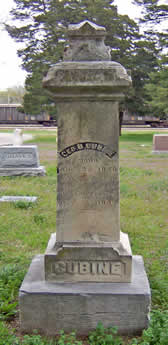 Cubine, George (1856-1892) * Cubine, George (1856-1892) *
George Cubine was a nephew of John W. Cubine and he assisted his uncle at the boot factory.
George Cubine will always be remembered as one of the Coffeyville citizens who lost his life during the Dalton Raid on Coffeyville, October 5, 1892. As Emmett and Bob Dalton ran for their horses, George Cubine, with a Winchester in his hands, shot but his own live was ended by the outlaws. The inscription on his stone reads:
A precious one from us has gone
A voice we loved is stilled
A place is vacant in our home
Which never can be filled
| top |
Cubine, Georgia (1877-1945)
Georgia Cubine was born and raised in Coffeyville. She was the daughter of the well-know John Cubine.
She was remembered as an excellent teacher but was also an avid swimmer establishing a national swim record in a meet off Catalina Island. Georgia attended high school in Coffeyville, received a bachelor’s degree from the University of Kansas and a Master’s degree from Columbia University. She attended Cambridge University of England and the University of Mexico in Mexico City.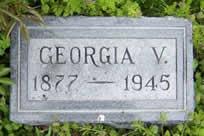
Georgia began teaching in Montgomery in 1899. In 1920, she taught in the Philippines for two years. In 1923, she was offered a full-time teaching position at Coffeyville Community Junior College. Georgia was the founder of Delta Kappa Gamma, a women teachers’ sorority in Kansas. While Georgia never married, she had a very full and busy life.
| top |
Cubine, John (1845-1911)
John Cubine was well-known as the designer and maker of the infamous Coffeyville western boots. He started his boot manufacturing business as a fifteen-year-old in Virginia. His family moved a great deal from Missouri to Chetopa, Kansas, and finally to Coffeyville in 1870.
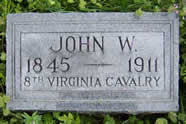 John’s first wife died in 1870, but not before the birth of their daughter, Maggie. John then remarried a woman named Alice Wright. Sometime later, his daughter died. John’s first wife died in 1870, but not before the birth of their daughter, Maggie. John then remarried a woman named Alice Wright. Sometime later, his daughter died.
Despite several personal tragedies, his boot manufacturing business thrived; his company was the first to make the “fitted boot” helping Coffeyville develop its western image. John was also the first boot maker to use tanned alligator hide on boots. He sold over 372 pairs of boots in 1891.
There once was an article in the Coffeyville Journal called “The Boot that Made Coffeyville Famous.” In the article, a man came across a camping ground in Utah where he noticed that all the cowboys were wearing boots with an identical pattern. When asked about the boots the cowboys simply replied, “They are made to order for us in Coffeyville, Kansas. All the boys around here wear Cubine boots!”
| top |
Dalton Defenders *
Anderson, M.N.
Ayers, Thomas G.
Baldwin, Lucius (Buried in the family plot in Burlington, Kansas)
Brown, Charles
Connelly, Charles (Buried in Independence, Kansas)
Cubine, George
Kloehr, John J.
| top |
Dalton Gang **
These members of the Dalton Gang were killed in Coffeyville on October 5, 1892. A portion of the hitching rail where they tethered their horses before the infamous raid on two Coffeyville banks is shown on the left and is a permanent part of the grave marker.
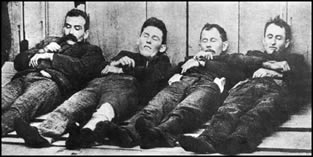
Broadwell, Dick (Buried by family in Hutchinson, Kansas)
Dalton, Emmett (Died in California. He was cremated and buried in the family plot in Kingfisher, Oklahoma.)
Dalton, Gratton (Grat)
Dalton, Robert (Bob)
Power, Bill
| top |
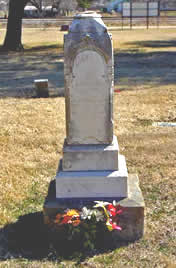 Dalton, Franklin (1859-1887) Dalton, Franklin (1859-1887)
Franklin Dalton was born June 8, 1859. Frank was a commissioned U.S. Deputy Marshal at Fort Smith, Arkansas, in 1884, and was killed near Fort Smith on November 27, 1887, while trying to arrest whiskey runners. It is not known for sure if Frank was married or not. No marriage record has been found and newspaper articles do not agree on his marital status. Frank was a widely respected law enforcement officer and his death was a real blow to his family and friends.
The Daltons’ mother tried to have Bob and Grat buried beside Frank after the Coffeyville raid. Indignant Coffeyville citizens said no. So in Elmwood, Frank Dalton is buried two cemetery blocks away from Bob and Grat. Frank Dalton’s monument is elaborate compared with his brothers. “Erected by his affectionate mother,” it bears this deeply religious sentiment:
“Whose God was thy ransom, thy guardian and guide. He gave thee; He took thee and He will restore thee. And death has no sting for the Savior has died.”
| top |
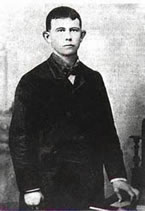 Dalton, Gratton (Grat) Hanley (1861-1892) ** Dalton, Gratton (Grat) Hanley (1861-1892) **
Gratton “ Grat” Hanley Dalton was born in 1861, the 7th of the Dalton siblings. Grat was named for old Kentucky neighbors who were also probably relatives.
Grat never married and he died in Coffeyville during the infamous bank robbery of October 5.
Before turning to crime, Grat had served as a U.S. Deputy Marshal for the Fort Smith court and had once been wounded in performance of his duties. In 1931 when brother Emmett returned to Coffeyville for a visit he said, “Poor Grat. Here he sleeps, an aimless, discontent boy who grew into a fierce fighting man.”
Grat was known as the best shot of the Dalton Gang, often firing from the hip.
| top |
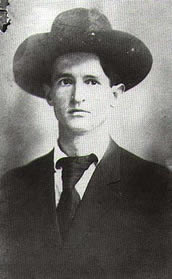 Dalton, Robert (Bob) Kennick (1869-1892) ** Dalton, Robert (Bob) Kennick (1869-1892) **
Robert “Bob” Kennick Dalton was born in 1869, the 10th child of James Lewis Dalton and Adeline Lee Younger. He was named for a chaplain with General Jo Shelby of Civil War fame.
Bob never married but there are various tales about a girlfriend who tapped telegraph lines to obtain information about trains with gold shipments. One story has her dying of cancer just before the Coffeyville raid.
Perhaps the first person that Bob killed was a man named Charlie Montgomery who was wanted for horse theft, impersonating a law officer, and several other offenses.
Bob was known as the most wild and reckless of the Dalton Gang.
| top |
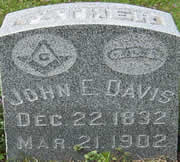 Davis, John E. (1832-1902) Davis, John E. (1832-1902)
John E. Davis was an early day Coffeyville farmer. He was very progressive in his farming techniques and he contributed much to the Coffeyville community, helping it to develop and thrive as an agricultural center.
| top |
Elliot, David Stewart (1843-1899)
Captain David Elliot held many jobs during his lifetime and he experienced several professions. At the age of 15, Elliott began working in a newspaper office where he learned the printing trade. In 1861, he enlisted in Company G of the Thirteenth Pennsylvania Volunteer Infantry and then he re-enlisted in Company I of the Seventeenth Pennsylvania Volunteers. Following his military career, he became editor of a newspaper in Bedford, Pennsylvania. In 1869, he was admitted to the Bar of Bedford County and began practicing law. After a few years he returned to the newspaper business for which he had a real passion.
 In 1885, he moved to Coffeyville where he became a member of the Montgomery County Bar Association. However, the newspaper business kept calling Elliott and he became editor of the Coffeyville Weekly Journal in 1892. Approximately ten years later, he enlisted in the Spanish-American War where he was shot in the line of duty by a Filipino sharp shooter. In 1885, he moved to Coffeyville where he became a member of the Montgomery County Bar Association. However, the newspaper business kept calling Elliott and he became editor of the Coffeyville Weekly Journal in 1892. Approximately ten years later, he enlisted in the Spanish-American War where he was shot in the line of duty by a Filipino sharp shooter.
Captain David Stewart Elliott died at age 56, having led a full life and serving his country in two wars. His wife Clara was a sister of J. J. Barndollar who is also buried in Elmwood Cemetery.
| top |
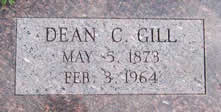 Gill, D. C. (1873-1964) Gill, D. C. (1873-1964)
The life of D. C. Gill is best remembered through the lines of a poem written by his daughter on Father’s Day and printed by the Coffeyville Journal. It is simply entitled, “A Tribute to Father.”
A tall quiet man with work worn hands,
Always kindly and gentle with family and friends,
A high sense of honor and courage to endure,
All hardships to come with a strength that was sure.
A soldier he was in a time long ago,
When the Blues fought the Grays in a war we all know.
Then off to a land that was barren and new
As a pioneer farmer his living to hew.
Come droughts, storms or floods he never complained
But pushed steadily on with whatever remained.
Always ready to help a neighbor or friend
Always ready to help a neighbor or friend
Always willing to share, to give, or to lend.
Family worries or troubles, whatever the plight
We’d take it to Father, he’d make it alright
Long years since he left, but his spirits stay near,
And I’ll always remember that kind face so dear.
A live well lived and nightly I pray
When this life is over, I’ll find him someday.
D. C. Gill’s daughter, author of the poem, died in 1975.
| top |
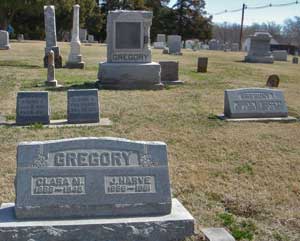 Gregory, J. H. (1868-1951) Gregory, J. H. (1868-1951)
Josiah Harve Gregory accompanied his parents to Montgomery County, Kansas, from DeSotum, Champaign County, Illinois in 1883. The Gregory’s moved to farms in Labette County, but their “trading town” remained Coffeyville.
J. H. married Clara May Beeson in 1889. J. H. and Clara bought their farm from Samuel Beeson and the Gregory’s lived on this same farm for the rest of their lives. Both, along with their three sons, are buried in Elmwood cemetery.
J. H. and Clara made one of their trading visits to Coffeyville October 5, 1892. Unaware of the significance of the day, they were enroute to Coffeyville in their horse drawn buggy at the time of the Dalton Raid.
| top |
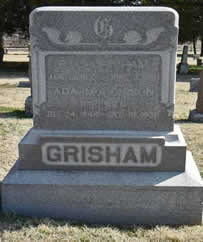 Grisham, Richard C. (1833-1911) Grisham, Richard C. (1833-1911)
Richard C. Grisham was one of the proprietors of the State Line Flouring Mills. He was a native of Brown County, Ohio, where he was born on August 19, 1833. In the spring of 1874, he came to Parker Township, Montgomery County and in February 1883, he and Austin Blake built one of the most complete flouring mills to be found anywhere. It was furnished with the Great Western Manufacturing Company’s purifiers, bolter, etc. Their company did merchant milling and their mill had a capacity of 80 barrels per day.
| top |
Herring, Clarence, Jessie and Ollie
In 1904, there was a head-on collision of two Missouri Pacific trains. One train was an east bound passenger train full of people on their way to the World's Fair in St. Louis, Missouri. In the wreck 30 people were killed. Clarence, Jessie and Ollie Herring, passengers on one of the trains, were killed in this tragic accident.
| top |
Hollingsworth, R. H.
On the day of the Dalton Raid, Mr. and Mrs. R. H. Hollingsworth saw the Dalton Gang riding into town from the west.
| top |
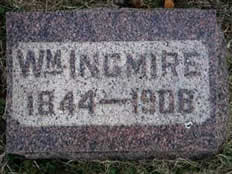 Ingmire, William (1844-1908) Ingmire, William (1844-1908)
William Ingmire was originally from Ohio but he migrated to Coffeyville in 1870 to farm. William had served as a private in the Union Army during the Civil War. After he was discharged from government service, he met his wife Amanda Shackelford in Missouri. The couple began their farming business on land located near Baxter Springs. Once the farm was thriving they sold it and moved to Coffeyville where they again “took up” farming.
William and his wife had five children with two surviving to adulthood. His land consisted of more than 114 acres. His home was originally located on Eighth Street in Coffeyville but it was later moved to Ninth Street because it stood on a government land grant. The property is now known as the Ingmire addition.
| top |
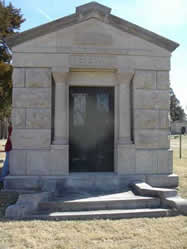 Isham, H. H. (1836-1906) Isham, H. H. (1836-1906)
Isham, John T. (1839-1907)
H. H. Isham was a native of Avon Springs, New York, where he was born November 22, 1836. In 1868, he moved to South Haven, Michigan, where he had a hardware business until July 1871, when he came to Coffeyville, Kansas. At the time, the town had one shanty and a tent where groceries were kept in the shanty and a little stock of hardware in the tent.
In October 1871, Mr. Isham, with his brother J. T. Isham, purchased hardware stock and they pursued the hardware business together until 1875, then H. H. went to Texas but his brother continued with the family business. J.T. primarily sold heavy and light hardware, stoves, tinware, agriculture implements, wagons, and carriages.
The Isham Hardware was the source of guns and ammunition for the defending citizens during the Dalton Raid. The Isham Hardware continues in business today.
| top |
Kloehr, John J. (1860-?) *
John J. Kloehr was one of the best known citizens of southern Kansas. He was born in Germany on June 30, 1860, to Joseph and Margaret Kloehr. Their family had been well-to-do millers in that country for generations. In 1870, Joseph Kloehr brought his family to America where they settled in Leroy, Kansas, and eventually went into the packing business. In 1872, the family moved to Coffeyville and built a handsome brick residence on a 220-acre tract near town. John Kloehr grew up in Coffeyville, tried several businesses such as prospecting for gold in Colorado, and finally returned to Coffeyville where he began buying and selling horses. He eventually had the leading livery business in town with stalls for 68 head of stock.
On October 5, 1892, Kloehr was reclining on a cot in the stable when the Dalton Gang arrival was announced. He immediately armed himself and is credited for shooting Dick Broadwell and killing Bob and Grat Dalton. The president of the First National Bank of Chicago presented him with a $1,000 gold and diamond medal for his bravery. Engraved upon the medal were these words, “John Joseph Kloehr – the Emergency Arose and the Man Appeared.” Mr. Kloehr was a citizen of whom Coffeyville was very proud.
| top |
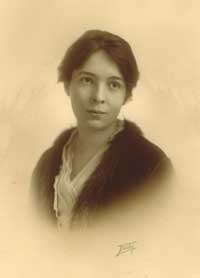 Kohler, Violet Elizabeth Brown (1885-1973) Kohler, Violet Elizabeth Brown (1885-1973)
Violet Elizabeth Brown Kohler was born in 1885 in Port Washington, Ohio. Shortly after her birth her parents, W.P. and Nancy Brown, moved to Coffeyville, Kansas.
At the age of 19 Violet moved out and married a man from the Wichita Eagle family. They divorced not long after their first and only child, a little boy, died. He only lived a short time.
Violet was what you might call an independent woman; she traveled the world, had a second marriage, and went to college. Her second husband was from a Swiss family who made chocolates. Violet went back to school following her second divorce and earned a degree in Library Science from the University of Wisconsin. She then became the librarian at Carnegie Library in Ponca City, Oklahoma.
Violet moved back to the Mansion to help her parents when her father became ill. She was 49 years old when her parents died. When they died they left the Brown Mansion to Violet. Since the depression had such a great effect on her family’s fortune there was not enough money for the upkeep of the home. In 1970 Violet decided to sell the mansion to the Coffeyville Historical Society to use as a museum. She took what she needed and moved into a nursing home in Independence, Kansas. Violet lived there until her death on November 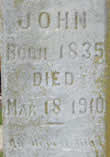 16,1973, at the age of 88. 16,1973, at the age of 88.
| top |
Morgan, John (1835-1910)
John Morgan’s tombstone reads: “An honest man.” On another side of the monument there is inscribed: “Born in bondage, died in Freedom.” The name “Cynthia” is inscribed without comment or other data.
| top |
 Patton, M. A. E. (1857-1914) Patton, M. A. E. (1857-1914)
Very little is known about Mr. Patton except that he was a businessman and had financial interests in the interurban system and natural gas wells like another well-known Coffeyville businessman, W. P. Brown.
| top |
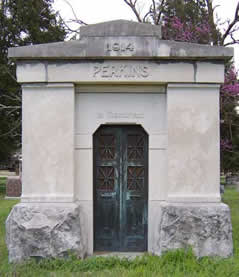 Perkins, Luther (1844-?) Perkins, Luther (1844-?)
Judge Luther Perkins was born in Boston, Massachusetts, on April 25, 1844, and lived there and in Chicago before locating to Coffeyville.
He graduated from the Boston Law School in June 1864, but he never became a member of the Bar of Montgomery County until June 29, 1895. After locating to Coffeyville, he became one of the most prominent men of the city and practicing in the judicial and police courts. For some time, he served as Judge of the Court of Coffeyville.
The building housing the old Condon Bank is known as the Perkins Building.
| top |
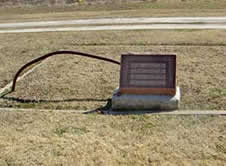 Power, Bill (Tim Evans) (?-1892) ** Power, Bill (Tim Evans) (?-1892) **
Bill Power was often called Tim Evans by those who knew him well. According to the Dalton Gang’s plan for robbing the two Coffeyville banks, Bill Power was assigned to assist Grat Dalton in robbing the Condon Bank.
He was shot while in the bank unable to use his shooting arm. When he finally managed to leave the bank, he and Grat were caught in the middle of crossfire between men on either side of the Plaza. He tried to hide in the rear door of a store, but the door was locked. As he staggered down the alley to his horse, another shot hit him in the back. He fell dead beside his horse.
| top |
Read, Hazzard W. (1850-1930)
Hazzard W. Read was the founder of H.W. Read’s Department Store, well known in theCoffeyville area for the quality of its merchandise for four generations. H. W.Read first came to Coffeyville in 1872 to assist his stepbrother in the clothing business. Eventually, the stepbrothers divided the 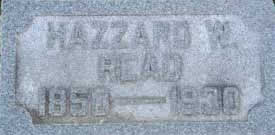 store’s merchandise with H. W. taking the women’s clothing lines. store’s merchandise with H. W. taking the women’s clothing lines.
He met his wife when she traveled from Kansas City to Coffeyville to visit relatives. They had six children.
H. W. became good friends with members of the Delaware Indian Tribe; they even made him an honorary chief.
| top |
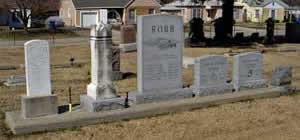 Robb Family Robb Family
The Robb Family was early Coffeyville pioneers dating back to the 1860s. They established Coffeyville’s’ first blacksmith shop in 1869. Note the horseshoes that are engraved on the monument of Charles Spencer Robb.
| top |
Schertz, Mildred Marie (1913-1973)
Mildred Schertz was a companion to Violet Elizabeth Brown Kohler, the daughter of W.P. Brown.
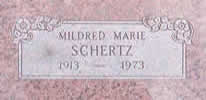 She worked for Violet for 37 years before her death in January of 1973. Because Violet had broken her hip and was an invalid she could not care for herself after Mildred’s death. The depression had a great effect on the Brown family fortune there was not enough money for the upkeep of the Mansion. Violet sold the Mansion to the Coffeyville Historical Society in April 1973 with the stipulation that it be open to the public and that the oriental rugs remain in place. Violet moved to a nursing home for the last few months of her life. She worked for Violet for 37 years before her death in January of 1973. Because Violet had broken her hip and was an invalid she could not care for herself after Mildred’s death. The depression had a great effect on the Brown family fortune there was not enough money for the upkeep of the Mansion. Violet sold the Mansion to the Coffeyville Historical Society in April 1973 with the stipulation that it be open to the public and that the oriental rugs remain in place. Violet moved to a nursing home for the last few months of her life.
| top |
Slosson, Minnie Hatch (1844-1928)
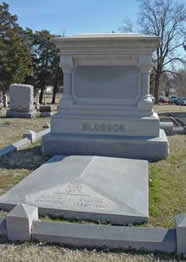 Minnie Slosson/Minnie Hatch was born in New York and met her husband, George Slosson, in Lawrence, Kansas. The couple moved to Coffeyville to establish their home. Minnie’s husband was known as a dignified and honorable man with an acute mind for business. He built the first brick business building in Coffeyville, served as the town’s first druggist, and owned several pieces of real estate. Minnie Slosson/Minnie Hatch was born in New York and met her husband, George Slosson, in Lawrence, Kansas. The couple moved to Coffeyville to establish their home. Minnie’s husband was known as a dignified and honorable man with an acute mind for business. He built the first brick business building in Coffeyville, served as the town’s first druggist, and owned several pieces of real estate.
The Slossons were very community minded and did all they could to support the town. George Slosson was a founder of the First National Bank which was later robbed by the Dalton Gang.
Minnie died in 1928, but she left $5,000 in her will to construct the stone shelter house for Elmwood Cemetery and another $5,000 for the beautiful iron gates and fence.
| top |
Stuckey, John (1831-1906)
Little is known about John and Maria Stuckey other than the fact that John was a brick  contractor and he provided much leadership to the lying of Coffeyville’s city street. contractor and he provided much leadership to the lying of Coffeyville’s city street.
| top |
Upham Family
The elder members of the Upham family were well along in years when they arrived in Coffeyville near the turn of the century. The grandfather was a Baptist minister and other family members made their living by selling real estate and managing the Willard Hotel.
| top |
Wells, Daniel (1848-
Wells, Robert L.
Daniel Wells and Robert L. Wells were well known Coffeyville merchants.
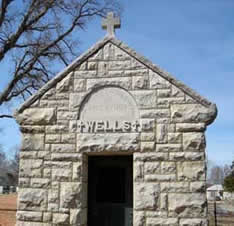 Daniel was born in Prince George’s County, Maryland, on August 26, 1848. He moved to Leavenworth, Kansas, in the spring of 1869. He then moved to Parker, Montgomery County, and embarked in mercantile business in partnership with his brother Robert L. Wells. Daniel was born in Prince George’s County, Maryland, on August 26, 1848. He moved to Leavenworth, Kansas, in the spring of 1869. He then moved to Parker, Montgomery County, and embarked in mercantile business in partnership with his brother Robert L. Wells.
Daniel and Robert continued their business at Parker until 1873, when they moved to Coffeyville. They built up an immense wholesale and retail business in general merchandise and also dealing in cattle, horses, ponies, wools, hides, and furs. The first year their business amounted to about$50,000.
| top |
|



 He moved to Coffeyville, May 25, 1880, and engaged in a banking business under the firm name of Ayres & Stule. This firm was afterwards dissolved and in its stead the First National Bank of Coffeyville was organized. Mr. Ayres continued in the business for some years with the new organization.
He moved to Coffeyville, May 25, 1880, and engaged in a banking business under the firm name of Ayres & Stule. This firm was afterwards dissolved and in its stead the First National Bank of Coffeyville was organized. Mr. Ayres continued in the business for some years with the new organization.  J. J. Barndollar, an early-day Coffeyville merchant, was born in Everett, Bedford County, Pennsylvania, on May 5, 1842. In 1868, he moved to Lanark, Illinois, where he resided until the spring of 1870, when he came to Humboldt, Kansas.
J. J. Barndollar, an early-day Coffeyville merchant, was born in Everett, Bedford County, Pennsylvania, on May 5, 1842. In 1868, he moved to Lanark, Illinois, where he resided until the spring of 1870, when he came to Humboldt, Kansas. 

 only 15 years of age, he went to California and engaged in gold mining for about 13 years.
only 15 years of age, he went to California and engaged in gold mining for about 13 years.



 W.P. Brown began plans for his home around the turn of the century. He contracted with the architectural firm of Wilder and Wight of Kansas City, Missouri to build a mansion, known today as the
W.P. Brown began plans for his home around the turn of the century. He contracted with the architectural firm of Wilder and Wight of Kansas City, Missouri to build a mansion, known today as the 

 John’s first wife died in 1870, but not before the birth of their daughter, Maggie. John then remarried a woman named Alice Wright. Sometime later, his daughter died.
John’s first wife died in 1870, but not before the birth of their daughter, Maggie. John then remarried a woman named Alice Wright. Sometime later, his daughter died. 




 In 1885, he moved to Coffeyville where he became a member of the Montgomery County Bar Association. However, the newspaper business kept calling Elliott and he became editor of the Coffeyville Weekly Journal in 1892. Approximately ten years later, he enlisted in the Spanish-American War where he was shot in the line of duty by a Filipino sharp shooter.
In 1885, he moved to Coffeyville where he became a member of the Montgomery County Bar Association. However, the newspaper business kept calling Elliott and he became editor of the Coffeyville Weekly Journal in 1892. Approximately ten years later, he enlisted in the Spanish-American War where he was shot in the line of duty by a Filipino sharp shooter. 

 Grisham, Richard C. (1833-1911)
Grisham, Richard C. (1833-1911)
 Isham, H. H. (1836-1906)
Isham, H. H. (1836-1906)




 store’s merchandise with H. W. taking the women’s clothing lines.
store’s merchandise with H. W. taking the women’s clothing lines. 
 She worked for Violet for 37 years before her death in January of 1973. Because Violet had broken her hip and was an invalid she could not care for herself after Mildred’s death. The depression had a great effect on the Brown family fortune there was not enough money for the upkeep of the Mansion. Violet sold the Mansion to the Coffeyville Historical Society in April 1973 with the stipulation that it be open to the public and that the oriental rugs remain in place. Violet moved to a nursing home for the last few months of her life.
She worked for Violet for 37 years before her death in January of 1973. Because Violet had broken her hip and was an invalid she could not care for herself after Mildred’s death. The depression had a great effect on the Brown family fortune there was not enough money for the upkeep of the Mansion. Violet sold the Mansion to the Coffeyville Historical Society in April 1973 with the stipulation that it be open to the public and that the oriental rugs remain in place. Violet moved to a nursing home for the last few months of her life.  Minnie Slosson/Minnie Hatch was born in New York and met her husband, George Slosson, in Lawrence, Kansas. The couple moved to Coffeyville to establish their home. Minnie’s husband was known as a dignified and honorable man with an acute mind for business. He built the first brick business building in Coffeyville, served as the town’s first druggist, and owned several pieces of real estate.
Minnie Slosson/Minnie Hatch was born in New York and met her husband, George Slosson, in Lawrence, Kansas. The couple moved to Coffeyville to establish their home. Minnie’s husband was known as a dignified and honorable man with an acute mind for business. He built the first brick business building in Coffeyville, served as the town’s first druggist, and owned several pieces of real estate.  contractor and he provided much leadership to the lying of Coffeyville’s city street.
contractor and he provided much leadership to the lying of Coffeyville’s city street. Daniel was born in Prince George’s County, Maryland, on August 26, 1848. He moved to Leavenworth, Kansas, in the spring of 1869. He then moved to Parker, Montgomery County, and embarked in mercantile business in partnership with his brother Robert L. Wells.
Daniel was born in Prince George’s County, Maryland, on August 26, 1848. He moved to Leavenworth, Kansas, in the spring of 1869. He then moved to Parker, Montgomery County, and embarked in mercantile business in partnership with his brother Robert L. Wells.